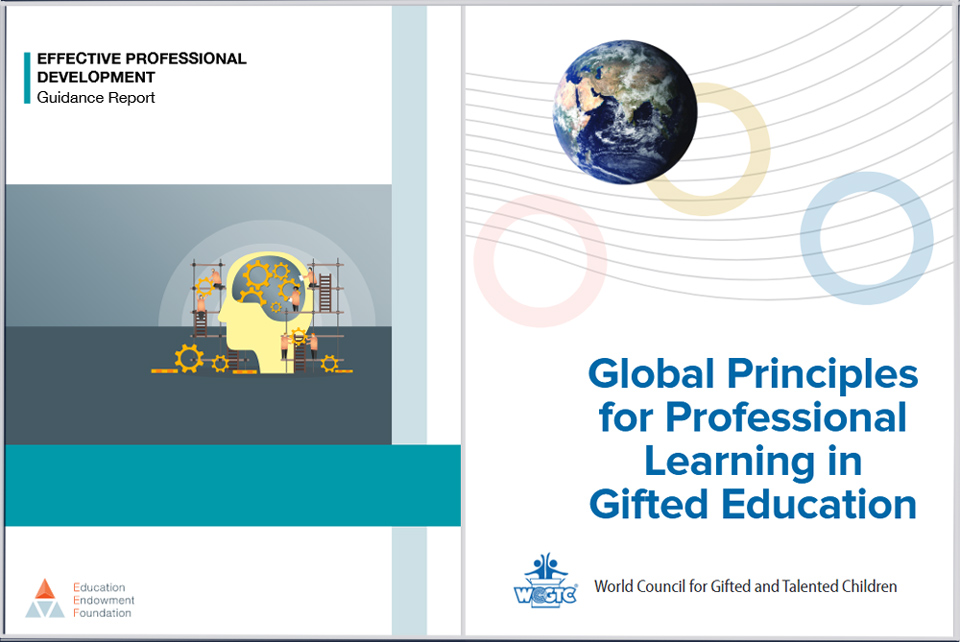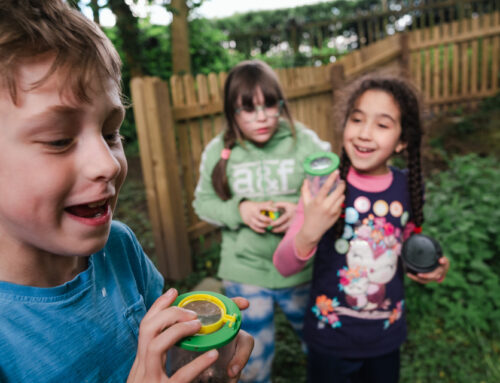Ensuring young people with high potential thrive academically and socially
Two recent research reports have drawn attention to the importance of high-quality professional learning for everyone involved in education. This blog will consider how schools can embed excellent practice to raise achievement for all. It draws from two respected sources:
- Global Principles for Professional Learning in Gifted Education. World Council for Gifted and Talented Children (WCfGTC) 2021. This report focuses particularly on high potential learners, drawing on best practice principles globally.
- Education Endowment Foundation (EEF). Effective Professional Development 2021. This report outlines best practice in planning, implementing, and monitoring professional learning in UK schools with useful summaries.
This powerful introduction from the WCfGTC report reminds us that great minds lead to great solutions.
“The new decade has provided stark reminders of the need for the world’s most able minds to be well-educated. The global pandemic, a warming planet, and shifting demographics present unprecedented, complex problems that require insight, expertise, creativity and cross-disciplinary collaboration. Even in the absence of dire crises, social progress is fueled by the innovation and insight of its most gifted citizens. We all benefit as their curiosity and vision move science, art and culture forward.”
Remember the Whole Child – It’s Not Always Easy for High Potential Learners
- All young people are unique and individual. The WCfGTC report emphasises, “A professional learning program should encourage teachers to think beyond a gifted student’s outstanding cognitive abilities and include the student’s affective needs”. (p.6) Professional learning can often focus on cognitive challenge yet does not help teachers to develop the tools to support learners’ social and emotional needs. Without this holistic approach, many gifted young people may struggle unnecessarily.
- All educators need some understanding of the characteristics and social needs of this group; it is a misconception that all high potential learners are ‘well-adjusted’. Freeman (2006), suggests that some face social and emotional challenges that result from being gifted.
- As many as one in six young people with high learning potential would also be classed as having dual or multiple exceptionality (DME) – that is having both high learning potential and SEND (Ronksley-Pavia, 2020; Silverman, 2012). Any professional learning programme needs to look at both strengths and learning challenges. Educators must understand how to look beyond the special educational need which often masks their giftedness.
- Underrepresentation of children with high learning potential, according to gender, across diverse cultural groups and income groups is a global problem (Bianco et al, 2011). Professional learning needs to raise awareness and address the needs of learners from different and diverse communities. It must be inclusive of racial, cultural, ethnic and indigenous groups, genders and sexual orientations. Monitoring the identification of high potential learners and engagement needs to be ongoing. Recruiting teachers and educators from representative diverse backgrounds is essential to provide role models and increase understanding. Professional learning must empower educators to be skilled in identifying and motivating high potential learners from all groups in society or we risk wasting the talents of these young people.
A Whole-School Approach
“It takes a village to raise a child,” is a well-known proverb and is important when promoting academic success and wellbeing in young people. It is cited in Global Principles One and Six (Tiered Content and Comprehensive) from the WCfGTC that recommends that all school personnel, within and beyond the classroom, need to be included in professional learning for gifted students. Not everyone needs the same depth of knowledge and expertise but everyone does need an awareness of who the high potential learners are and their typical characteristics. Some examples of responsibilities to high potential learners include:
- The SENDCo and Classroom/Teaching Assistants,who are likely to support children with Dual or Multiple Exceptionality (DME), working closely with the High Learning Potential Lead to meet all the needs of individuals
- The Careers Advisor who must source appropriate work experience and university visits
- Admin staff who will interact with high potential learners and their parents regularly and need to know of specific programmes or co-curricular activities and how they benefit these learners
- Counsellors and psychologists who need to understand the characteristics of high potential learners and how these may impact on their mental health and behaviours
- Visitors, speakers and professional learning providers who must understand the school’s context, approach to high potential learners and the needs of this group.
Education Endowment Foundation (EEF) Key Findings and Implications for High Learning Potential
EEF Effective Professional Development Report
This report recommends paying close attention to the mechanisms that make up effective professional development at the planning stage. These include Building Knowledge, Motivating Staff, Developing Teaching Techniques and Embedding Practice. If any of these mechanisms are missing, professional development will not be effective.
- If Building Knowledge is missing, educators may misunderstand or lack the deep understanding needed to apply their learning accurately.
- If Motivating Staff does not happen, nothing will change, so they need to fully understand why the professional development is important and how it will raise achievement and improve well
- If Developing Teaching Techniques is missing, educators may want to implement their learning but don’t know how or have the tools to do this.
- If Embedding Practice is missing, educators are likely to revert to old habits.
Conclusions
Potential Plus UK knows that high quality professional learning:
- Is key to raising achievement for every learner and crucial to meeting the needs of high potential learners
- Includes all school staff at an appropriate, relevant and targeted level
- Embeds latest research into classroom practice
- Needs careful planning and embedding over time
- Must be championed by senior leaders as an entitlement for all staff
- Is an effective recruitment and retention strategy
- Is collaborative so that sustained support is built in and staff are motivated.
High quality professional learning leads towards a common goal, improving the life chances and social mobility for high potential learners. The EEF and WCfGTC reports provide excellent insights into excellence in professional learning and are well-worth investigating further.
Suggestions for Schools
- Undertake a Best Practice Audit. Consider working through the Professional Learning section to identify next steps in professional learning to meet the needs of young people with high potential.
- View the free webinar about Ofsted available to members of Potential Plus UK, which provides insights into how inspectors will make judgements about provision for high potential learners in UK schools and the implications for senior and subject leaders.
- Sign up for the Education Endowment Foundation free updates on easy-to-use research https://educationendowmentfoundation.org.uk/ .
- Visit Potential Plus UK’s menu of professional learning training courses which would make a great starting point.
References
Bianco, M., Harris, B., Garrison-Wade, D., & Leech, N. (2011). Gifted girls: Gender bias in gifted referrals. Roeper Review, 33(3), 170-181. https://doi.org/10.1080/02783193.2011.580500
Education Endowment Fund. (2021). Effective Professional Development: Guidance Report. https://d2tic4wvo1iusb.cloudfront.net/eef-guidance-reports/effective-professional-development/EEF-Effective-Professional-Development-Guidance-Report.pdf
Ronksley-Pavia, M. (2020). Twice-exceptionality in Australia: Prevalence estimates. Australasian Journal of Gifted Education, 29(2), 17-29.
Silverman, L. K. (2012). Giftedness 101. Springer Publishing Company.
World Council for Gifted and Talented Children. (2021). Global principles for professional learning in gifted education. https://world-gifted.org/professional-learning-global-principles.pdf
Useful Links
School Advice Sheets – Social and Emotional Needs of High Potential Learners Please note that access to these advice sheets is free to member schools via the members’ area.
Blog: Ofsted Update – What Schools Need to Know About High Learning Potential
About the Authors:
Joy Morgan was a senior leader in London schools until August 2021. She has helped many schools to develop their policy and to improve their practice for high potential learners. Joy is passionate about securing excellent outcomes for disadvantaged learners and is a Trustee of Potential Plus UK.
Mary Phillips was the Head of English before setting up her own educational consultancy, supporting senior leaders and classroom teachers as a coach and mentor. Mary facilitates a wide range of professional learning and has lived experience of the challenges and joys of living with a child with high learning potential.






